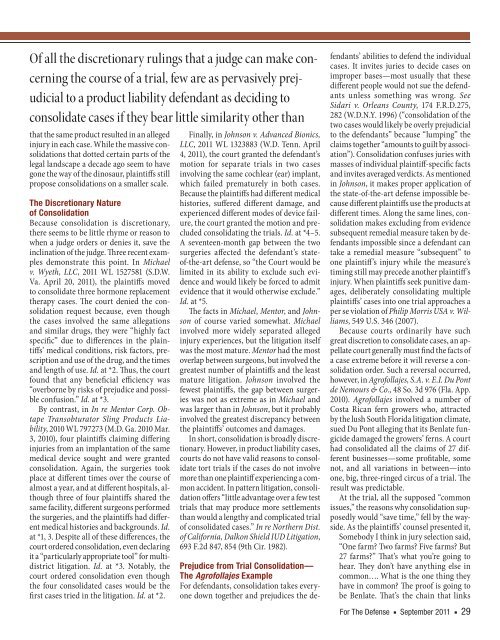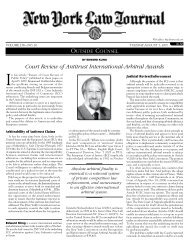Little in Common: Opposing Trial Consolidation in Product ... - Dechert
Little in Common: Opposing Trial Consolidation in Product ... - Dechert
Little in Common: Opposing Trial Consolidation in Product ... - Dechert
Create successful ePaper yourself
Turn your PDF publications into a flip-book with our unique Google optimized e-Paper software.
Of all the discretionary rul<strong>in</strong>gs that a judge can make concern<strong>in</strong>g<br />
the course of a trial, few are as pervasively prejudicial<br />
to a product liability defendant as decid<strong>in</strong>g to<br />
consolidate cases if they bear little similarity other than<br />
that the same product resulted <strong>in</strong> an alleged<br />
<strong>in</strong>jury <strong>in</strong> each case. While the massive consolidations<br />
that dotted certa<strong>in</strong> parts of the<br />
legal landscape a decade ago seem to have<br />
gone the way of the d<strong>in</strong>osaur, pla<strong>in</strong>tiffs still<br />
propose consolidations on a smaller scale.<br />
The Discretionary Nature<br />
of <strong>Consolidation</strong><br />
Because consolidation is discretionary,<br />
there seems to be little rhyme or reason to<br />
when a judge orders or denies it, save the<br />
<strong>in</strong>cl<strong>in</strong>ation of the judge. Three recent examples<br />
demonstrate this po<strong>in</strong>t. In Michael<br />
v. Wyeth, LLC, 2011 WL 1527581 (S.D.W.<br />
Va. April 20, 2011), the pla<strong>in</strong>tiffs moved<br />
to consolidate three hormone replacement<br />
therapy cases. The court denied the consolidation<br />
request because, even though<br />
the cases <strong>in</strong>volved the same allegations<br />
and similar drugs, they were “highly fact<br />
specific” due to differences <strong>in</strong> the pla<strong>in</strong>tiffs’<br />
medical conditions, risk factors, prescription<br />
and use of the drug, and the times<br />
and length of use. Id. at *2. Thus, the court<br />
found that any beneficial efficiency was<br />
“overborne by risks of prejudice and possible<br />
confusion.” Id. at *3.<br />
By contrast, <strong>in</strong> In re Mentor Corp. Obtape<br />
Transobturator Sl<strong>in</strong>g <strong>Product</strong>s Liability,<br />
2010 WL 797273 (M.D. Ga. 2010 Mar.<br />
3, 2010), four pla<strong>in</strong>tiffs claim<strong>in</strong>g differ<strong>in</strong>g<br />
<strong>in</strong>juries from an implantation of the same<br />
medical device sought and were granted<br />
consolidation. Aga<strong>in</strong>, the surgeries took<br />
place at different times over the course of<br />
almost a year, and at different hospitals, although<br />
three of four pla<strong>in</strong>tiffs shared the<br />
same facility, different surgeons performed<br />
the surgeries, and the pla<strong>in</strong>tiffs had different<br />
medical histories and backgrounds. Id.<br />
at *1, 3. Despite all of these differences, the<br />
court ordered consolidation, even declar<strong>in</strong>g<br />
it a “particularly appropriate tool” for multi-<br />
district litigation. Id. at *3. Notably, the<br />
court ordered consolidation even though<br />
the four consolidated cases would be the<br />
first cases tried <strong>in</strong> the litigation. Id. at *2.<br />
F<strong>in</strong>ally, <strong>in</strong> Johnson v. Advanced Bionics,<br />
LLC, 2011 WL 1323883 (W.D. Tenn. April<br />
4, 2011), the court granted the defendant’s<br />
motion for separate trials <strong>in</strong> two cases<br />
<strong>in</strong>volv<strong>in</strong>g the same cochlear (ear) implant,<br />
which failed prematurely <strong>in</strong> both cases.<br />
Because the pla<strong>in</strong>tiffs had different medical<br />
histories, suffered different damage, and<br />
experienced different modes of device failure,<br />
the court granted the motion and precluded<br />
consolidat<strong>in</strong>g the trials. Id. at *4–5.<br />
A seventeen- month gap between the two<br />
surgeries affected the defendant’s stateof-the-art<br />
defense, so “the Court would be<br />
limited <strong>in</strong> its ability to exclude such evidence<br />
and would likely be forced to admit<br />
evidence that it would otherwise exclude.”<br />
Id. at *5.<br />
The facts <strong>in</strong> Michael, Mentor, and Johnson<br />
of course varied somewhat. Michael<br />
<strong>in</strong>volved more widely separated alleged<br />
<strong>in</strong>jury experiences, but the litigation itself<br />
was the most mature. Mentor had the most<br />
overlap between surgeons, but <strong>in</strong>volved the<br />
greatest number of pla<strong>in</strong>tiffs and the least<br />
mature litigation. Johnson <strong>in</strong>volved the<br />
fewest pla<strong>in</strong>tiffs, the gap between surgeries<br />
was not as extreme as <strong>in</strong> Michael and<br />
was larger than <strong>in</strong> Johnson, but it probably<br />
<strong>in</strong>volved the greatest discrepancy between<br />
the pla<strong>in</strong>tiffs’ outcomes and damages.<br />
In short, consolidation is broadly discretionary.<br />
However, <strong>in</strong> product liability cases,<br />
courts do not have valid reasons to consolidate<br />
tort trials if the cases do not <strong>in</strong>volve<br />
more than one pla<strong>in</strong>tiff experienc<strong>in</strong>g a common<br />
accident. In pattern litigation, consolidation<br />
offers “little advantage over a few test<br />
trials that may produce more settlements<br />
than would a lengthy and complicated trial<br />
of consolidated cases.” In re Northern Dist.<br />
of California, Dalkon Shield IUD Litigation,<br />
693 F.2d 847, 854 (9th Cir. 1982).<br />
Prejudice from <strong>Trial</strong> <strong>Consolidation</strong>—<br />
The Agrofollajes Example<br />
For defendants, consolidation takes everyone<br />
down together and prejudices the de-<br />
fendants’ abilities to defend the <strong>in</strong>dividual<br />
cases. It <strong>in</strong>vites juries to decide cases on<br />
improper bases—most usually that these<br />
different people would not sue the defendants<br />
unless someth<strong>in</strong>g was wrong. See<br />
Sidari v. Orleans County, 174 F.R.D.275,<br />
282 (W.D.N.Y. 1996) (“consolidation of the<br />
two cases would likely be overly prejudicial<br />
to the defendants” because “lump<strong>in</strong>g” the<br />
claims together “amounts to guilt by association”).<br />
<strong>Consolidation</strong> confuses juries with<br />
masses of <strong>in</strong>dividual pla<strong>in</strong>tiff- specific facts<br />
and <strong>in</strong>vites averaged verdicts. As mentioned<br />
<strong>in</strong> Johnson, it makes proper application of<br />
the state-of-the-art defense impossible because<br />
different pla<strong>in</strong>tiffs use the products at<br />
different times. Along the same l<strong>in</strong>es, consolidation<br />
makes exclud<strong>in</strong>g from evidence<br />
subsequent remedial measure taken by defendants<br />
impossible s<strong>in</strong>ce a defendant can<br />
take a remedial measure “subsequent” to<br />
one pla<strong>in</strong>tiff’s <strong>in</strong>jury while the measure’s<br />
tim<strong>in</strong>g still may precede another pla<strong>in</strong>tiff’s<br />
<strong>in</strong>jury. When pla<strong>in</strong>tiffs seek punitive damages,<br />
deliberately consolidat<strong>in</strong>g multiple<br />
pla<strong>in</strong>tiffs’ cases <strong>in</strong>to one trial approaches a<br />
per se violation of Philip Morris USA v. Williams,<br />
549 U.S. 346 (2007).<br />
Because courts ord<strong>in</strong>arily have such<br />
great discretion to consolidate cases, an appellate<br />
court generally must f<strong>in</strong>d the facts of<br />
a case extreme before it will reverse a consolidation<br />
order. Such a reversal occurred,<br />
however, <strong>in</strong> Agrofollajes, S.A. v. E.I. Du Pont<br />
de Nemours & Co., 48 So. 3d 976 (Fla. App.<br />
2010). Agrofollajes <strong>in</strong>volved a number of<br />
Costa Rican fern growers who, attracted<br />
by the lush South Florida litigation climate,<br />
sued Du Pont alleg<strong>in</strong>g that its Benlate fungicide<br />
damaged the growers’ ferns. A court<br />
had consolidated all the claims of 27 different<br />
bus<strong>in</strong>esses—some profitable, some<br />
not, and all variations <strong>in</strong> between—<strong>in</strong>to<br />
one, big, three-r<strong>in</strong>ged circus of a trial. The<br />
result was predictable.<br />
At the trial, all the supposed “common<br />
issues,” the reasons why consolidation supposedly<br />
would “save time,” fell by the wayside.<br />
As the pla<strong>in</strong>tiffs’ counsel presented it,<br />
Somebody I th<strong>in</strong>k <strong>in</strong> jury selection said,<br />
“One farm? Two farms? Five farms? But<br />
27 farms?” That’s what you’re go<strong>in</strong>g to<br />
hear. They don’t have anyth<strong>in</strong>g else <strong>in</strong><br />
common…. What is the one th<strong>in</strong>g they<br />
have <strong>in</strong> common? The proof is go<strong>in</strong>g to<br />
be Benlate. That’s the cha<strong>in</strong> that l<strong>in</strong>ks<br />
For The Defense ■ September 2011 ■ 29










